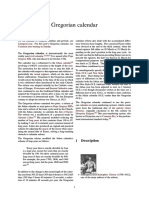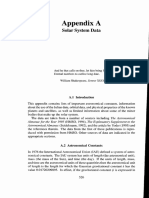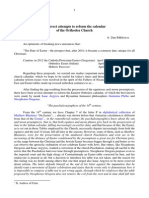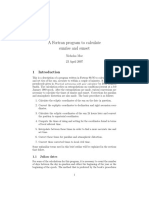J 200
Uploaded by
bomansmithJ 200
Uploaded by
bomansmithA Julian year is an interval with the length of a mean year in the Julian calend
ar, i.e. 365.25 days. This interval measure does not itself define any epoch: th
e Gregorian calendar is in general use for dating. But, standard conventional ep
ochs which are not Besselian epochs have been often designated nowadays with a p
refix "J", and the calendar date to which they refer is widely known, although n
ot always the same date in the year: thus "J2000" refers to the instant of 12h o
n 1 January 2000, and J1900 refers to the instant of 12h (midday) on 0 January 1
900, equal to 31 Dec 1899.[10] It is also usual now to specify on what time scal
e the time of day is expressed in that epoch-designation, e.g. often Terrestrial
Time.
In addition, an epoch optionally prefixed by "J" and designated as a year with d
ecimals (2000 +x), where x is positive or negative and quoted to 1 or 2 decimal
places, has come to mean a date that is an interval of x Julian years of 365.25
days away from the epoch J2000 = JD 2451545.0 (TT), still corresponding (in spit
e of the use of the prefix "J" or word "Julian") to the Gregorian calendar date
of 2000 Jan 1 at 12h TT (about 64 seconds before noon UTC on the same calendar d
ay).[9] (See also Julian year (astronomy).) Like the Besselian epoch, an arbitra
ry Julian epoch is therefore related to the Julian date by
J =
The
nox
0.0
2000.0 + (Julian date - 2451545.0)/365.25 .
IAU decided at their General Assembly of 1976[11] that the new standard equi
of J2000.0 should be used starting in 1984. Before that, the equinox of B195
seems to have been the standard.[citation needed]
Different astronomers or groups of astronomers used to define epochs to suit the
mselves, but nowadays standard epochs are generally defined by international agr
eement through the IAU, so astronomers worldwide can collaborate more effectivel
y. It is inefficient and error-prone if data or observations of one group have t
o be translated in non-standard ways so that other groups could compare the data
with information from other sources. An example of how this works: if a star's
position is measured by someone today, he/she then uses a standard transformatio
n to obtain the position expressed in terms of the standard reference frame of J
2000, and it is often then this J2000 position which is shared with others.
You might also like
- 0 (Year) : Counting Intervals Without A ZeroNo ratings yet0 (Year) : Counting Intervals Without A Zero9 pages
- Gregorian Calendar: 2021 in Various CalendarsNo ratings yetGregorian Calendar: 2021 in Various Calendars16 pages
- Historical Financial Statistics: Calendar NotesNo ratings yetHistorical Financial Statistics: Calendar Notes13 pages
- For Other Uses, See Leap Year (Disambiguation)No ratings yetFor Other Uses, See Leap Year (Disambiguation)4 pages
- Frequently Asked Questions About Calendars (Claus Tøndering) 2005No ratings yetFrequently Asked Questions About Calendars (Claus Tøndering) 200563 pages
- Frequently Asked Questions About Calendars: Claus Tøndering 15 December 2005No ratings yetFrequently Asked Questions About Calendars: Claus Tøndering 15 December 200563 pages
- Incorrect Attempts To Reform The Calendar of The Orthodox ChurchNo ratings yetIncorrect Attempts To Reform The Calendar of The Orthodox Church7 pages
- Leap Year: From Wikipedia, The Free EncyclopediaNo ratings yetLeap Year: From Wikipedia, The Free Encyclopedia5 pages
- The PI (π) Cycle Secret of the 360-days year calendar: Time to reset the calendar back to 360 days a yearFrom EverandThe PI (π) Cycle Secret of the 360-days year calendar: Time to reset the calendar back to 360 days a yearNo ratings yet
- Watch Repair for Beginners: An Illustrated How-To Guide for the Beginner Watch RepairerFrom EverandWatch Repair for Beginners: An Illustrated How-To Guide for the Beginner Watch Repairer3.5/5 (3)
- Calendar It is Structure and History and ImprovemetsNo ratings yetCalendar It is Structure and History and Improvemets128 pages
- Astronomical Algorithms Amended Multi-Millennia CANo ratings yetAstronomical Algorithms Amended Multi-Millennia CA4 pages
- Babylonian, Jewish, Muslim, Luni-Solar, Indian, Iranian Calendars100% (1)Babylonian, Jewish, Muslim, Luni-Solar, Indian, Iranian Calendars32 pages
- Determine Orthodox Easter Date by Spreadsheet For Ancient or Near DatesNo ratings yetDetermine Orthodox Easter Date by Spreadsheet For Ancient or Near Dates1 page
- 16.346 Astrodynamics: Mit OpencoursewareNo ratings yet16.346 Astrodynamics: Mit Opencourseware2 pages
































































